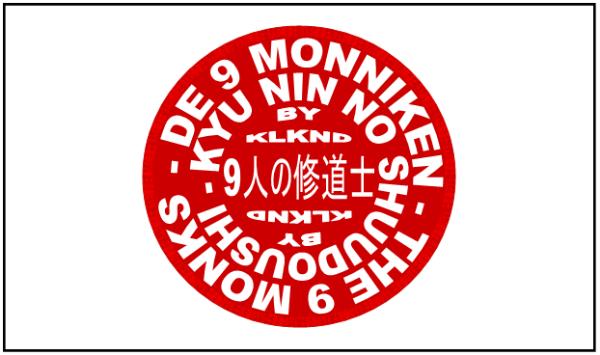De 9 monniken / The 9 monks - Cache 9 Multi-Cache
KLKND: De cache container is regelmatig weg.
De 9 monniken / The 9 monks - Cache 9
-
Difficulty:
-

-
Terrain:
-

Size:  (small)
(small)
Please note Use of geocaching.com services is subject to the terms and conditions
in our disclaimer.
Bovenstaande coordinaten zijn niet de coordinaten waar de cache te vinden is!!!
The above coordinates are not the actual cache location coordinates!!!

Deze cache is één van de “Negen Monniken” serie geplaatst door 9 medewerkers van een Japans bedrijf.
Iedere cache heeft een aanwijzing voor de BONUS. B=...
This cache is one of the “nine monks” serie placed by 9 employees of a Japanese company.
Each cache has a clue for the BONUS. B=...

|

|

NINJA
|
Ninja's werden in speciale gevechts- en camouflagetechnieken getraind.
Ninja waren noch boeren, noch een "antwoord op de samurai".
De Ninja is 'geboren' in de bergen. De boeren mochten geen vechtsport beoefenen en mochten absoluut niet laten merken dat zij op een of andere manier weerstand konden bieden. Om deze reden hebben mensen zich getraind in verschillende vechtkunsten en al deze vechtkunsten hebben zich in één vorm gemixt die we dezer dagen kennen als Ninjutsu.
Mensen die niet in de bergen woonden of helemaal niets te maken hadden met de cultuur van deze boeren, wisten helemaal niet dat deze boeren zich zo bekwaam aan het maken waren in deze vorm van vechten. Vanaf een jaar of vier werden kinderen al ingewijd in deze vorm van vechtkunst.
De volwassen ninja hebben zich zeer zwaar weten te verzetten tegen de samurai,het keizerlijke leger.De ninja waren zo succesvol dat zelfs de Ronin en de heersende keizer de bergmensen,ofwel de ninja, in gingen huren voor clandestiene Operaties.
Vermoedelijk werd het concept "ninja" ontwikkeld door gevluchte samurai die geen zin zagen in rituele zelfmoord omdat hun heer verslagen was. Zij trokken zich terug in onherbergzame gebieden.
De ninja heeft zich altijd weten te hullen in een vorm van mystiek. Zelfs hedendaags is er erg weinig bekend over de originele ninja en of deze nog steeds bestaat in de hedendaagse japanse cultuur. |
Ninja's were trained in special combat- and camouflage-techniques. Ninja were neither farmers, nor an "answer to the Samurai". The Ninja is 'born' in the mountains. The farmers weren't allowed to practice combat techniques and most of all not allowed to show that they could offer resistance. Therefore the people trained themselves in a variaty of martial arts and combined it in the art we currently know as Ninjitsu
People who didn't live in the mountains or weren't connected to the farmingculture, didn't know the farmers where getting themselves skilled in this form of martial art. From the age of 4, children we're introduced to this martial art.
Adult ninja's were able to put up a good fight against the Samurai. The ninja was so successful that even the Ronin and the ruling emperor started to use the mountainpeople, or ninja, for clandestine operations.
Probably the concept "ninja" was invented by a fled samurai who was reluctant to commit suicide when his lord was defeated. These Samurai took shelter in the mountains.
The ninja has always been veiled in a form of mystery. Even today little is known about the original ninja and or its existence in the contemporary Japanese culture |
| |

SAMURAI
|
Het woord “samurai” is afkomstig van het Japanse woord “samourau”, wat vrij vertaald betekend: dienen, dienaar.
Men gaat er nu van uit dat de samurai-klasse zo rond de 12e eeuw als zodanig is opgekomen.
De samurai ontwikkelen eigen gedragscodes, die beïnvloed zijn door het boeddhisme en door shintô en waarin moed, trouw, eer en onverzettelijkheid de boventoon voeren.Deze gedragscode wordt wel “bushido” genoemd, de weg van de krijger. |
The word “samurai” is derived from the Japanse word “samourau”, which means: to serve, servant.
Today it is assumed that the samurai-class started around the 12th century.
The samurai developed their own code of conduct, which was influenced by Boeddhisme, shintô and courage, loyalty and honour where key words. This code of conduct is also called “Bushido”, the way of the warrior. |
| |

SUMO
|
Sumo is een traditionele Japanse worstelsport
Aan de top van de sumo worstelaars hierachie (Banzuke) staat de Yokozuna (grote kampioen)
Op dit moment is er maar een Yokuzuna, Asashoryu van Mongolia.
Heeft iemand de status van yokuzuna bereikt, dan raakt hij hem niet meer kwijt. Hij wordt wel geacht met pensioen te gaan op het moment dat zijn resultaten verslechteren. |
Sumo is a traditional Japanese wrestlingsport
At the top of the sumo wrestlers hierarchy (Banzuke) stands the Yokozuna (Grand Champion).
At this moment there is only one Yokuzuna, Asashoryu from Mongolia.
Once a wrestler reaches the rank of yokozuna, he can never lose this rank. However, he's expected to retire as soon as he shows the first signs of weakening. |
| |
Hoe vind je de cache?
Punt 1:
- Ga naar N 52°16,919' E 006°08,154'
Hier vind je een micro met de info voor punt 2
Punt 2:
- Ga naar N 52°1G,EBA' E 006°0H,0FK'

Cache Punt:
N 52 1M.LNR E 006 0S.0RS
|
How to find the cache?
Point 1:
- Go to N 52°16,919' E 006°08,154'
Here you'll find a micro containing information for point 2
Point 2:
- Go to N 52°1G,EBA' E 006°0H,0FK'

Cache Point:
N 52 1M.LNR E 006 0S.0RS
|
Additional Hints
(Decrypt)
Uvagf:
Chag 1: Npugre qr obbz.
Chag 2 : mvr fcbvyresbgb, npugre qr obbz
Chag 3/ rvaqpnpur : npugre rra obbzfgebax